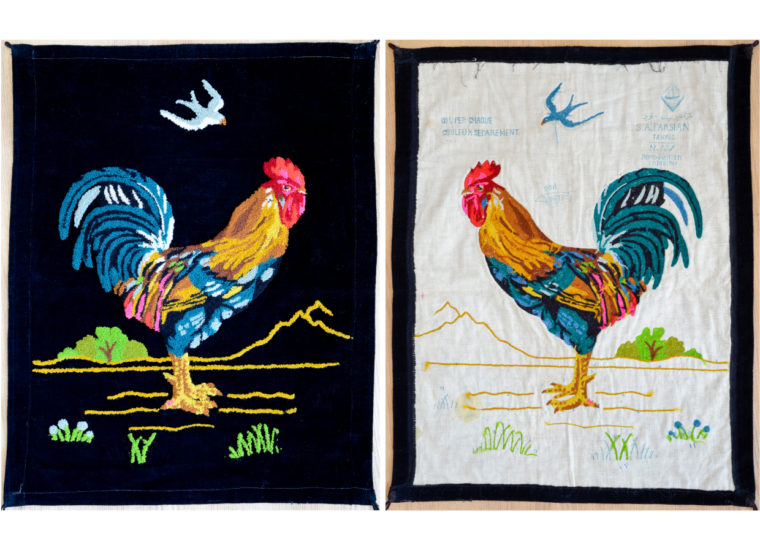We’re continuing our new series, Sewn Stories, which is all about the garments or textiles that have meant the most in your life, either sewn by you or by someone else. Please join me in welcoming Mithra Ballesteros who is a blogger and stylist. She’s with us today to talk about the rooster in her kitchen. Here’s her story. We hope you enjoy reading this as much as we did! And if you would like to contribute your own Sewn Story, here’s how to do it. We also encourage you to share your stories on Instagram with #sewnstories.
In a small corner of my kitchen hangs this framed needlepoint rooster, one of my most beloved possessions. My Persian grandmother stitched it when she was a young girl living in Hamadan, Iran, probably sometime in the 1920s.
Her name was Zarrin and she was very talented with a needle. After her father died, she supported herself and her mother with her own handiwork. Then, in 1927, she met and married my grandfather. I think this is a piece she did before her marriage.
After her marriage, my grandmother told her new husband that she wished to study French and music. It was not typical for a woman to play an instrument, or for a married woman to continue an education in any way. But she was his second wife –young, intelligent and beautiful–and he obliged. They made their home in the Jewish section of town away from the judgmental eyes of the Muslim community and my grandfather arranged for a Jewish instructor from the nearby school to come to the house. Zarrin took lessons on the tar, a sitar-like instrument, one day a week and learned French another day.
During this time in Iran, the Shah was on a campaign to modernize the country and he forbade women veiling themselves in public. As a result, many women did not leave their homes. My grandmother, however, went out daily, and the only thing covering her hair was a French hat.
She was an unusual woman. I wish I had known her better. For most of my life, we were separated by oceans. Later, when she came to live with my family in America, I was already in college. But I have this needlepoint. The closer I study it, the more I see.
The instructions on the back are written in Farsi and in French. This delights me to no end because I, like my grandmother, am a lover of all things French. From the diagram that details the rooster’s eye, or “oeil,” it is clear that this was not an easy pattern. I imagine my grandmother taking great care to execute the flinty look in that rooster’s eye.
Despite the complexity, I find no evidence of mistakes or tangled threads. The pattern is as clearly discernible on the reverse as it is on the front. Proof, I believe, of my grandmother’s skill. (Persian rugs are the same way. If you want to judge a rug’s quality, turn it over to examine the knots.)
The last thing I notice is that the canvas is not quite completed. My grandmother leaves blades of grass. Maybe she ran out of thread? I prefer to think that she chose not to finish. Maybe she figured the thing was good enough.
I love her for not finishing. She let the unimportant things go. I like to think we have that trait in common as well.
She would not agree with me though, that her needlepoint merited a frame and a place of honor in my house. Nor a few paragraphs in an essay. She herself quit needlepointing when she had a chance at a more valuable education. It’s only canvas and thread.
As smart as she was, my grandmother couldn’t look into the future and see that one day her vibrant rooster would become the most treasured possession of her college-educated American granddaughter.
photo credit: Renn Kuhnen

